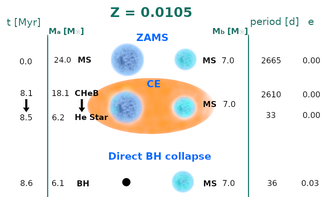
HR 6819 was reported in Rivinius et al. (2020) to be a triple system composed of a Be star on a wide orbit around the inner binary, which is thought to be made of a B3 III star and a dormant black hole. Alternatively, the Be star could also be spatially coinciding with the other objects and HR 6819 could just be a black hole-main sequence binary.
In a recet study, "Testing the presence of a dormant black hole inside HR 6819", group of astronomers from the Copernicus Astronomical Center: A. Romagnolo, A. Olejak, A. Hypki, G. Wiktorowicz, K. Belczynski, checked if the system’s inner binary could be reconstructed through the isolated binary formation channel in the Galactic field or the dynamical one within globular star clusters. In order to do so, astronomers assumed that either the outer Be star is unbound to the inner binary or the outer orbit is so wide that it does not affect its evolution. On top of that, authors of the reported work adopted some non-standard physical assumptions for both stellar and binary evolution. First, they assumed the black hole formed through the direct collapse of its progenitor (i.e. no supernova explosion) regardless of its initial mass, and secondly, they set a high efficiency for the common envelope orbital energy loss (> 4.5, while it’s usually < 1).
Authors additionally built a synthetic population of black hole-main sequence binaries with StarTrack code to understand how likely a binary resembling the HR 6819 inner binary can form and consequently be detected. Moreover, they have searched for all the binaries within numerical simulations of globular clusters done with MOCCA code in order to find all possible candidates for the system HR 6819.
The group found that despite this binary can be reconstructed with the isolated binary formation channel only, the optimal initial parameter space that is needed to evolve a binary system from ZAMS to the black hole collapse is so narrow that only 0.0001% of their black hole-main sequence synthetic population fits the observational constraints. This result suggests that, even with non-standard physical assumptions, a system similar to the HR 6819 inner binary is extremely unlikely to form and therefore be detected. Similar conclusion was drawn from the analysis of the numerical simulations of globular clusters. Only a few candidates for HR 6819 were found but none of them fully matched the desired parameters.
Authors then argue that the absence of a third body proposed by El-Badry & Quataert (2021) and Bodensteiner, J. et al. (2020) might be a more natural explanation for the HR 6819 system.
Main picture (at the top of the note):
This diagram brings an example of an isolated binary evolutionary scenario that brings a binary to evolve into a black hole-main sequence system resembling the one reported for the HR 6819 inner binary. The binary contains at the beginning two stars with a metallicity of 0.0105 and masses of 24 and 7 solar masses. The system evolves through a common envelope phase that causes the more massive star to lose most of its mass and collapse into a black hole, while at the same time decreasing the orbital distance and increasing the orbital eccentricity of the system.
Acknowledgements:
The work was supported by Polish National Science Center grants Maestro 2018/30/A/ST9/00050 and 2016/23/B/ST9/02732.






